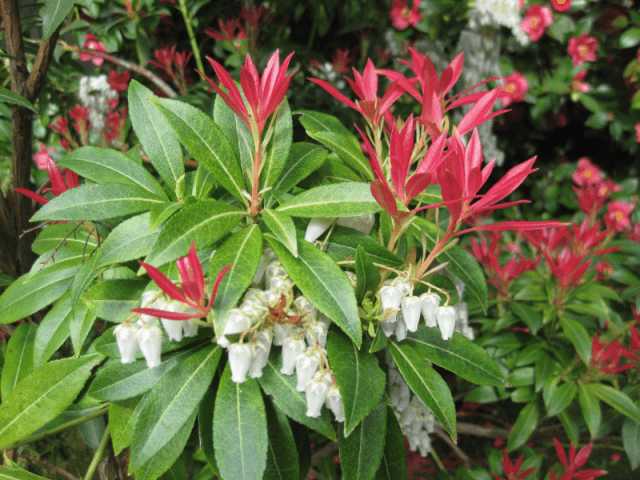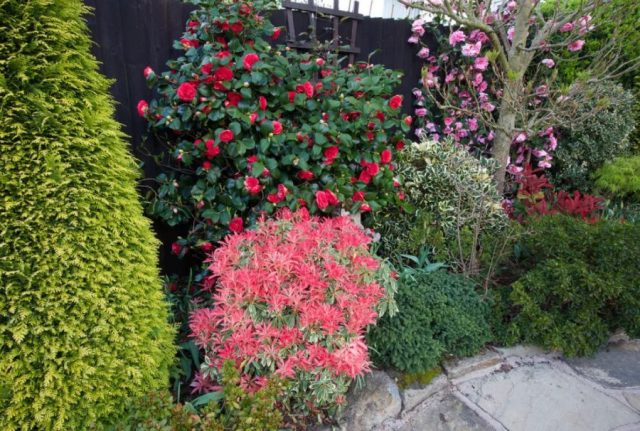Content
Before planting a crop on a site, you need to carefully study its characteristics.
What does a pieris plant look like?
Pieris is a plant of the Ericaceae family, which is a shrub or woody vine. It has numerous pinkish or reddish shoots and oval or elongated leaves with a solid or serrated edge. At the tops the plates are slightly pointed, their surface is shiny, with pronounced wrinkles. The leaves of the plant reach about 10 cm in length, and only about 3.5 cm in width. On the shoots, the plates are arranged spirally or collected in bunches at the tops of the stems.

The height of the Japanese pieris plant reaches about 2 m
In mid-spring, Japanese pieris bears drooping, bell-shaped buds in red, white or pink. The flowers of the plant are collected in small clusters. In summer, fruits are formed - lignified capsules up to 6 cm long with numerous seeds. The plant is characterized by slow development; during the growing season it can change color from bronze and reddish to emerald green.
In its natural form, the perennial is found in North America and the Himalayas. It is usually located in bushes and on wooded mountain slopes. The plant prefers acidic soils, as it often enters into symbiosis with fungi.
Pieris winter hardiness
Winter hardiness of Japanese pieris is average. In open ground, the flower can withstand cold temperatures down to -15 °C with minimal shelter. Some perennial varieties can tolerate negative temperatures down to -30 °C.
At the same time, spring return frosts pose a certain danger to the crop. If the plant has already entered a period of active growing season, a sudden cold snap can damage its young shoots and disrupt flowering.
Types and varieties of Pieris
The pieris shrub is represented by numerous species and decorative varieties. Several plants are especially popular among gardeners.
Beautiful (Pieris formosa)
This type of plant, popular among gardeners, is suitable for planting in closed containers and in the ground. It has long shoots that change color from bright red to green as it matures. Brings paniculate inflorescences of a white hue.

Beautiful pieris blooms a little later than other species - at the end of spring
Flaming Silver
The plant stretches up to 1.5 m above the ground, has dark green shiny leaves, silvery along the edges.The young shoots of the variety are pinkish. The flowers are shaped like lily of the valley buds and are red or pink in color.

Flaming Silver grows well in partial shade and sun
Forest Flame
A low variety up to 1 m is characterized by slow growth. Forms a fairly dense compact shrub with pink, cream or green shoots. The young leaves of the variety are also colored reddish-brown. It produces red or white bells and flowers in March and April.

Forest Flame has low frost resistance
Abundant bloomer (Pieris floribunda)
A small shrub up to 2 m in height has branched shoots and dark green elongated leaves with a leathery matte surface. The flowers of the variety are white, small, collected in clusters at the tops of the stems. The plant tolerates frost and shading well, but does not respond well to strong winds and heavy soil.

The abundantly flowering pieris produces buds from March to May.
Japanese (Pieris japonica)
The ornamental species reaches about 2 m above the ground, has oval leaves, copper-red or whitish after emergence, dark green in adulthood. The flowers are bell-shaped with white petals and bloom very profusely in March and April.

Japanese pieris is considered the most frost-resistant species and tolerates cold temperatures down to -30 ° C
Purity
A compact perennial up to 60 cm tall with rounded outlines. The leaves of the plant are narrow and elongated. The buds are greenish, blooming with snow-white small flowers forming hanging racemes. The perennial is suitable for planting in mixed borders and rockeries.

Puriti variety tolerates cold temperatures down to -27 °C
Red Mill
An evergreen ornamental plant rises up to 1 m above the ground. In spring it produces bright red leaves, which then turn dark green. The variety's flowers are bell-shaped and white, appearing on shoots in March and April.

The Red Mill variety tolerates cold temperatures down to -25 °C
Planting pieris in open ground
For a pieris flower on a site, you need to choose a well-lit place with light morning shading. The plant needs to be protected from wind and cold drafts. Pieris needs acidic soil; in alkaline soil the culture develops very poorly.
Before planting the shrub, the chosen place is dug up properly. Sand, humus and pine needles should be added to the soil to increase acidity, as well as fertilizers containing sulfur. After this, a shallow but fairly wide hole is dug in the area and filled with a mixture of garden soil and peat. The Pieris planting algorithm looks like this:
- The bush is carefully lowered in the center of the prepared hole.
- The seedling is buried so that the root collar is level with the surface of the earth.
- Fill the remaining voids with soil.
- Press down the soil with your hands and water generously.
Pieris is usually planted on a site no earlier than mid-May. You need to wait until the soil warms up properly and the night frosts finally pass.
Caring for pieris in open ground
Growing pieris in your summer cottage is quite simple. Throughout the season there are several things you need to pay attention to.
Watering and fertilizing
Pieris loves moisture, but reacts negatively to swampy soil. When growing a shrub, you need to ensure that the soil at its roots always remains slightly damp.The soil should not dry out completely, but it should also not be allowed to become limp. Typically, in summer, pieris is watered up to twice a week in dry weather. During the rainy season, the intensity of moisture is reduced.
For irrigation use lukewarm water with a soft composition. You can use rain or melt liquid. If pieris grows on slightly acidic soil, it is recommended to add peat, as well as citric acid or vinegar, to the water for irrigation.
From early spring until the end of autumn, the bush is fed with complex minerals every 2-3 weeks. You need to choose preparations that contain potassium, phosphorus and nitrogen, but do not contain lime impurities. It is also allowed to use organic matter as fertilizer for pieris in the spring, for example, an infusion of mullein or bird droppings.
Is pruning necessary?
Slow-growing pieris usually does not need formation. But every year it undergoes sanitary pruning. In early spring and mid-autumn, remove all dry and damaged shoots from the plant, as well as crooked branches directed into the bush.
With regular pruning, pieris receives more light and fresh air. This improves its development and promotes abundant flowering.
Wintering shrubs
Many types of pieris have good frost resistance. However, the root system of the plant is superficial, so leaving it in open ground without shelter is allowed only in the southernmost regions.
Photos of planting pieris in the Urals and caring for it show that in areas with a harsh climate, the shrub is carefully mulched with the onset of autumn. The plant needs to be covered with dry leaves or peat, and then covered with spruce branches. After snow falls, a snowdrift is formed over the bush, providing additional protection from wind and frost.
Disease and pest control
With good care, Pieris is rarely affected by fungi and insects. But in unfavorable conditions the danger for him is:
- aphid - a small insect clings to the leaves and feeds on the juices of the plant;
For aphids, the pieris plant is sprayed with a solution of laundry soap
- spider mite - the pest attacks perennials in hot, dry weather, whitish dots appear on the plates, and a thin cobweb appears on the shoots;
Calendula infusion helps get rid of spider mites
- chlorosis - with this disease, the leaves of the plant turn yellow along the veins, gradually the pieris dries out and dies.
Chlorosis can be eliminated by adding peat or iron chelate to the soil
For symptoms of fungal infections, dark spots and soft spots on the plates, it is necessary to treat the bushes with copper sulfate or Bordeaux mixture. Diseases can be prevented by following the rules of agricultural technology. If you do not over-moisten the pieris and monitor the composition of the soil, the plant will not suffer from fungus.
Reproduction of Pieris
There are several ways to propagate pieris on a site. New varieties are often sown by seed, and vegetative methods are used to propagate existing plants.
Seeds
Pieris is planted for seedlings in early March. For the plant, select a shallow container with drainage holes at the bottom. The soil is prepared from a mixture of coniferous soil, peat and sand in a ratio of 2:2:1. Both the container and the substrate are pre-spilled with a solution of Fitosporin to eliminate possible bacteria.
Planting pieris with seeds is done as follows:
- Moisten the soil generously in the prepared container.
- Scatter the seeds of the plant over the surface of the soil.
- Lightly press into the ground with your fingers.
- Sprinkle a thin layer of substrate on top.
- Cover the container with film.
For the first few weeks, the box is only ventilated from time to time and the soil is moistened when it dries out. When shoots appear, the film will need to be removed. The seedlings are moved to a lighted window and grown indoors.
Cuttings
At the end of summer, pieris can be propagated on the site by cuttings. From a healthy adult bush, several semi-lignified shoots up to 10 cm long with 2-3 nodes are cut. The cuttings are placed in a loose substrate with the addition of sand and peat, moistened and covered with cut bottles.
After the shoots take root, new leaves will appear on them. At this point, the cuttings can be carefully transferred to a permanent place in the garden.
Layerings and root shoots
To propagate pieris by layering, it is necessary to bend a flexible young shoot to the ground at the beginning of summer. It should be secured from straightening in the middle part, and then sprinkled with soil. During the summer, the cuttings are watered, and in the fall they are separated and transferred to a permanent site.
An adult pieris over 4-5 years old produces root shoots abundantly. In early spring, after the snow has melted, you can dig up the plant and separate the strongest and most well-developed shoots. They are treated with an anti-rotting fungicide and transferred to individual holes. With moderate watering, root areas germinate quickly.
Pieris in landscape design
The pieris plant in landscape design is most often used for planting in Japanese gardens and alpine hills. Varieties with a dense crown are also suitable for forming hedges. Pieris can be planted singly in the center of the lawn - it will attract attention due to its bright color.
The perennial goes well with rhododendrons and azaleas, as well as hydrangeas and ferns. In close proximity to shrubs, any plants that prefer acidic soil thrive.

You can plant pieris in the garden next to conifers
Conclusion
Pieris is a very beautiful and rather unpretentious perennial crop. When growing shrubs, you need to pay attention mainly to winter insulation. Most varieties tolerate frost quite poorly.
Reviews of Pieris











